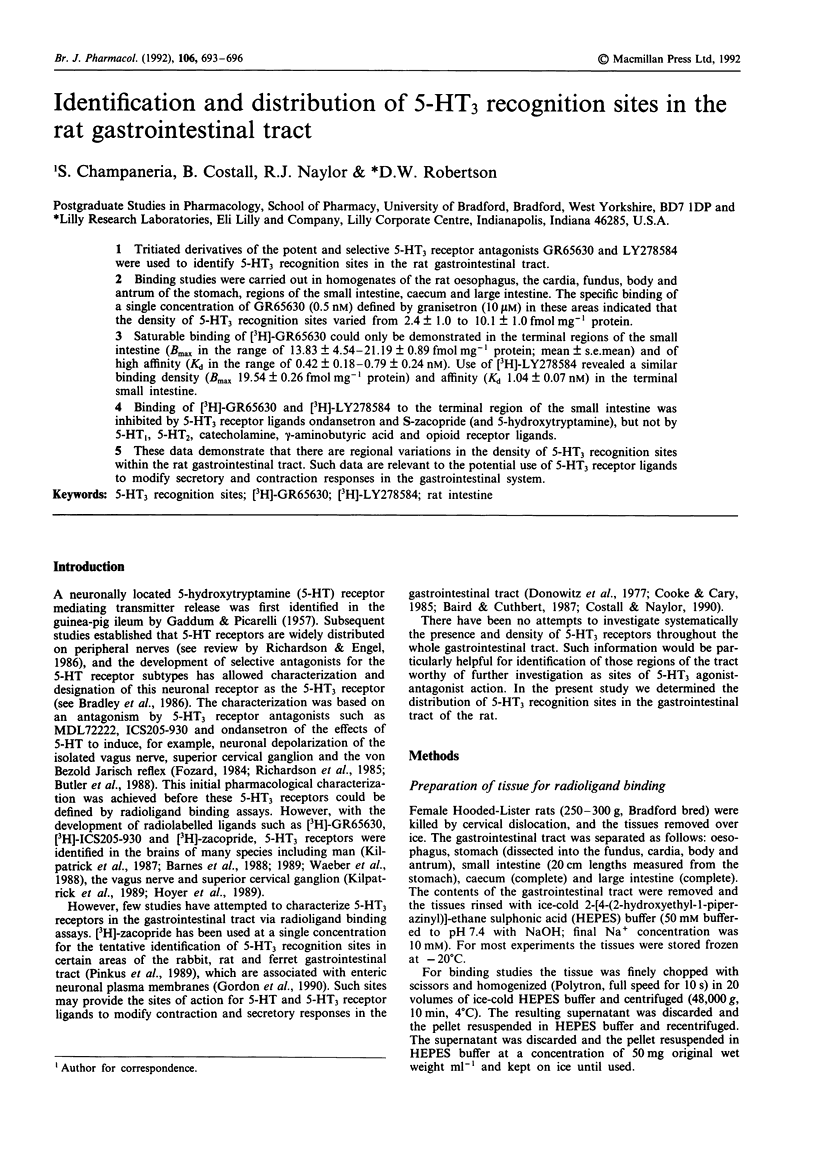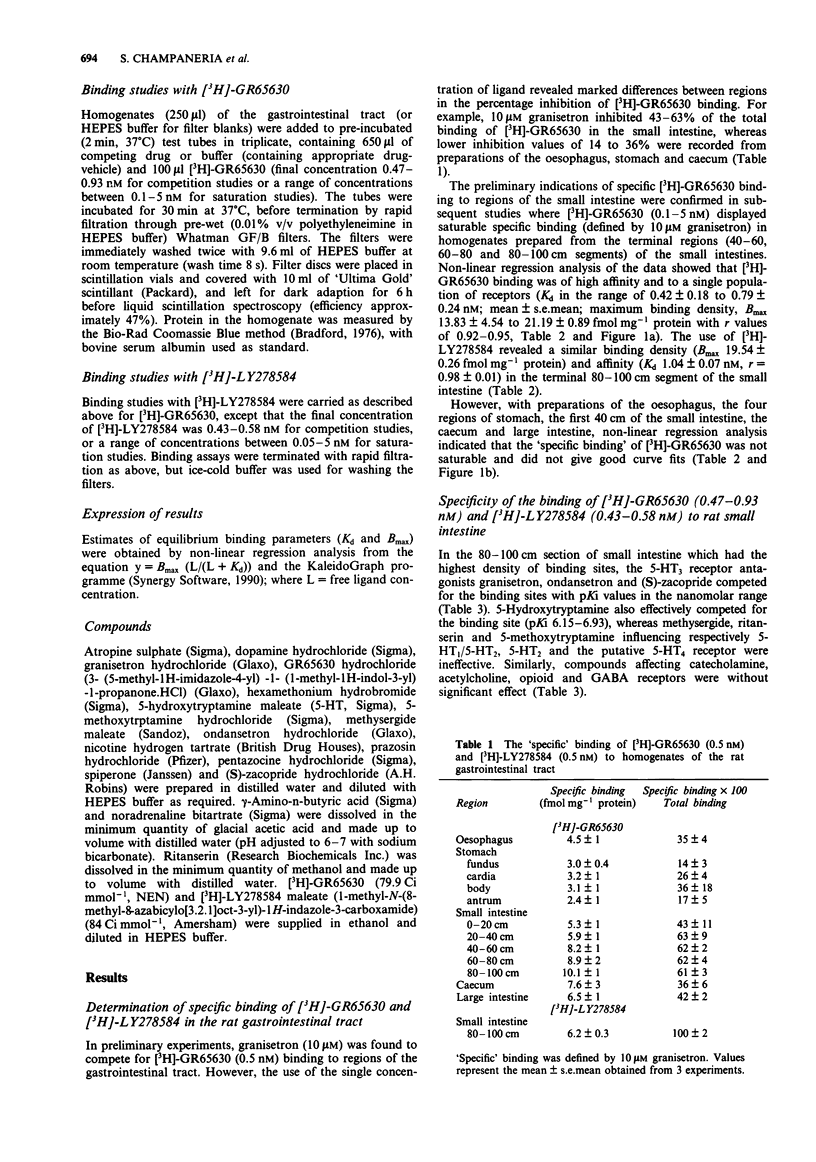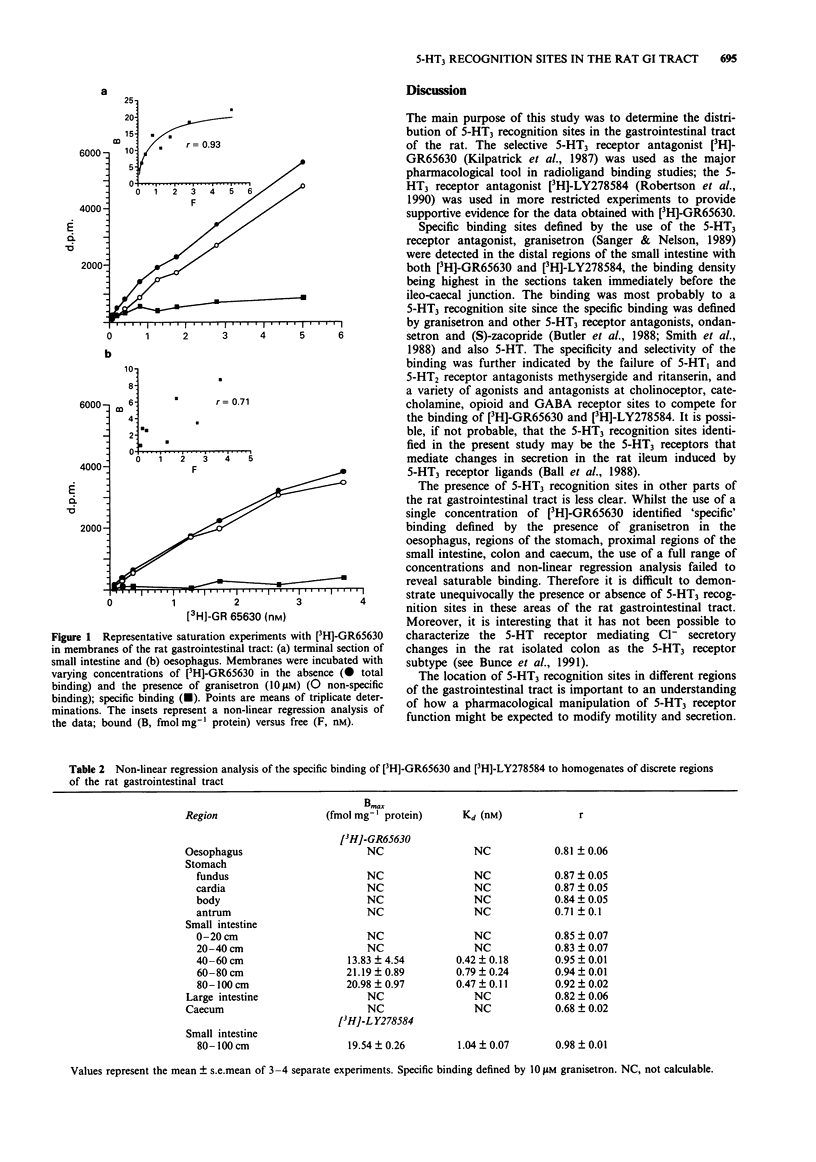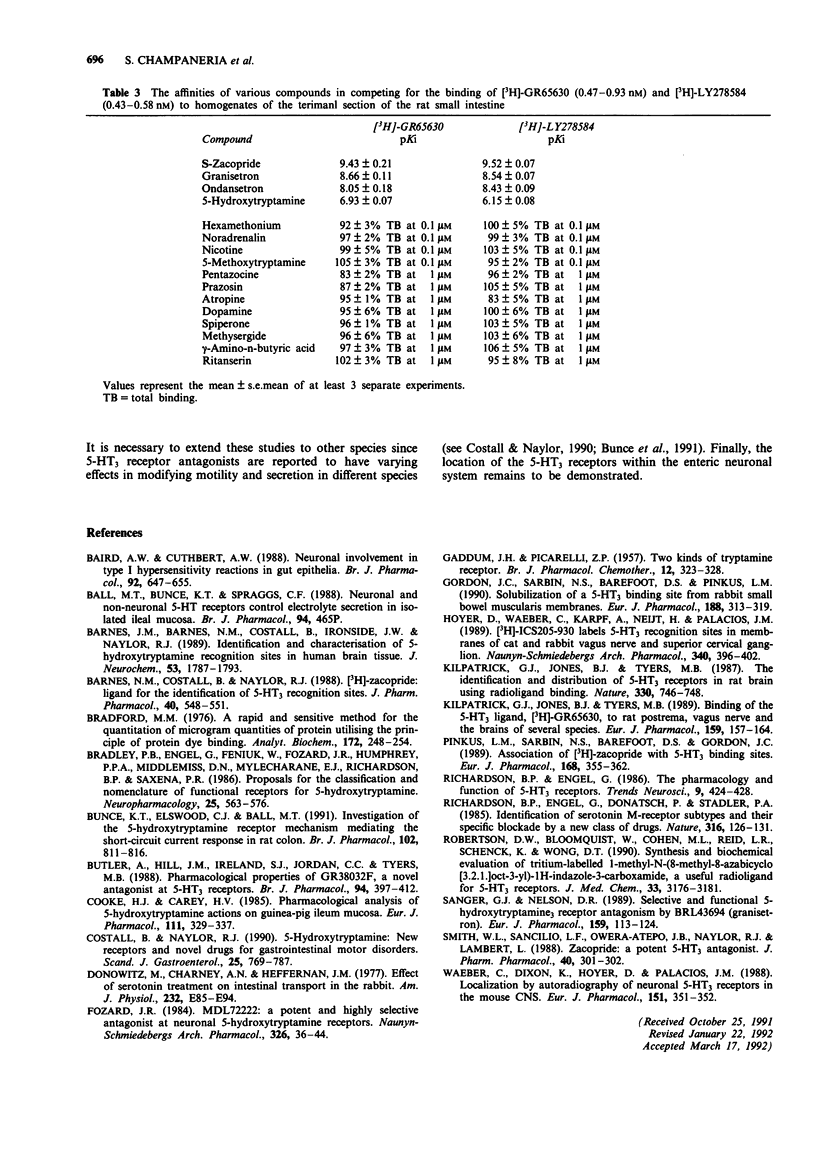Abstract
1. Tritiated derivatives of the potent and selective 5-HT3 receptor antagonists GR65630 and LY278584 were used to identify 5-HT3 recognition sites in the rat gastrointestinal tract. 2. Binding studies were carried out in homogenates of the rat oesophagus, the cardia, fundus, body and antrum of the stomach, regions of the small intestine, caecum and large intestine. The specific binding of a single concentration of GR65630 (0.5 nM) defined by granisetron (10 microM) in these areas indicated that the density of 5-HT3 recognition sites varied from 2.4 +/- 1.0 to 10.1 +/- 1.0 fmol mg-1 protein. 3. Saturable binding of [3H]-GR65630 could only be demonstrated in the terminal regions of the small intestine (Bmax in the range of 13.83 +/- 4.54-21.19 +/- 0.89 fmol mg-1 protein; mean +/- s.e. mean) and of high affinity (Kd in the range of 0.42 +/- 0.18-0.79 +/- 0.24 nM). Use of [3H]-LY278584 revealed a similar binding density (Bmax 19.54 +/- 0.26 fmol mg-1 protein) and affinity (Kd 1.04 +/- 0.07 nM) in the terminal small intestine. 4. Binding of [3H]-GR65630 and [3H]-LY278584 to the terminal region of the small intestine was inhibited by 5-HT3 receptor ligands ondansetron and S-zacopride (and 5-hydroxytryptamine), but not by 5-HT1, 5-HT2, catecholamine, gamma-aminobutyric acid and opioid receptor ligands. 5. These data demonstrate that there are regional variations in the density of 5-HT3 recognition sites within the rat gastrointestinal tract. Such data are relevant to the potential use of 5-HT3 receptor ligands to modify secretory and contraction responses in the gastrointestinal system.
Full text
PDF



Selected References
These references are in PubMed. This may not be the complete list of references from this article.
- Baird A. W., Cuthbert A. W. Neuronal involvement in type 1 hypersensitivity reactions in gut epithelia. Br J Pharmacol. 1987 Nov;92(3):647–655. doi: 10.1111/j.1476-5381.1987.tb11368.x. [DOI] [PMC free article] [PubMed] [Google Scholar]
- Barnes J. M., Barnes N. M., Costall B., Ironside J. W., Naylor R. J. Identification and characterisation of 5-hydroxytryptamine 3 recognition sites in human brain tissue. J Neurochem. 1989 Dec;53(6):1787–1793. doi: 10.1111/j.1471-4159.1989.tb09244.x. [DOI] [PubMed] [Google Scholar]
- Barnes N. M., Costall B., Naylor R. J. [3H]zacopride: ligand for the identification of 5-HT3 recognition sites. J Pharm Pharmacol. 1988 Aug;40(8):548–551. doi: 10.1111/j.2042-7158.1988.tb05300.x. [DOI] [PubMed] [Google Scholar]
- Bradford M. M. A rapid and sensitive method for the quantitation of microgram quantities of protein utilizing the principle of protein-dye binding. Anal Biochem. 1976 May 7;72:248–254. doi: 10.1006/abio.1976.9999. [DOI] [PubMed] [Google Scholar]
- Bradley P. B., Engel G., Feniuk W., Fozard J. R., Humphrey P. P., Middlemiss D. N., Mylecharane E. J., Richardson B. P., Saxena P. R. Proposals for the classification and nomenclature of functional receptors for 5-hydroxytryptamine. Neuropharmacology. 1986 Jun;25(6):563–576. doi: 10.1016/0028-3908(86)90207-8. [DOI] [PubMed] [Google Scholar]
- Bunce K. T., Elswood C. J., Ball M. T. Investigation of the 5-hydroxytryptamine receptor mechanism mediating the short-circuit current response in rat colon. Br J Pharmacol. 1991 Apr;102(4):811–816. doi: 10.1111/j.1476-5381.1991.tb12257.x. [DOI] [PMC free article] [PubMed] [Google Scholar]
- Butler A., Hill J. M., Ireland S. J., Jordan C. C., Tyers M. B. Pharmacological properties of GR38032F, a novel antagonist at 5-HT3 receptors. Br J Pharmacol. 1988 Jun;94(2):397–412. doi: 10.1111/j.1476-5381.1988.tb11542.x. [DOI] [PMC free article] [PubMed] [Google Scholar]
- Cooke H. J., Carey H. V. Pharmacological analysis of 5-hydroxytryptamine actions on guinea-pig ileal mucosa. Eur J Pharmacol. 1985 May 20;111(3):329–337. doi: 10.1016/0014-2999(85)90639-9. [DOI] [PubMed] [Google Scholar]
- Costall B., Naylor R. J. 5-Hydroxytryptamine: new receptors and novel drugs for gastrointestinal motor disorders. Scand J Gastroenterol. 1990 Aug;25(8):769–787. doi: 10.3109/00365529008999215. [DOI] [PubMed] [Google Scholar]
- Donowitz M., Charney A. N., Heffernan J. M. Effect of serotonin treatment on intestinal transport in the rabbit. Am J Physiol. 1977 Jan;232(1):E85–E94. doi: 10.1152/ajpendo.1977.232.1.E85. [DOI] [PubMed] [Google Scholar]
- Fozard J. R. MDL 72222: a potent and highly selective antagonist at neuronal 5-hydroxytryptamine receptors. Naunyn Schmiedebergs Arch Pharmacol. 1984 May;326(1):36–44. doi: 10.1007/BF00518776. [DOI] [PubMed] [Google Scholar]
- GADDUM J. H., PICARELLI Z. P. Two kinds of tryptamine receptor. Br J Pharmacol Chemother. 1957 Sep;12(3):323–328. doi: 10.1111/j.1476-5381.1957.tb00142.x. [DOI] [PMC free article] [PubMed] [Google Scholar]
- Gordon J. C., Sarbin N. S., Barefoot D. S., Pinkus L. M. Solubilization of a 5-HT3 binding site from rabbit small bowel muscularis membranes. Eur J Pharmacol. 1990 Jun 12;188(6):313–319. doi: 10.1016/0922-4106(90)90191-y. [DOI] [PubMed] [Google Scholar]
- Hoyer D., Waeber C., Karpf A., Neijt H., Palacios J. M. [3H]ICS 205-930 labels 5-HT3 recognition sites in membranes of cat and rabbit vagus nerve and superior cervical ganglion. Naunyn Schmiedebergs Arch Pharmacol. 1989 Oct;340(4):396–402. doi: 10.1007/BF00167040. [DOI] [PubMed] [Google Scholar]
- Kilpatrick G. J., Jones B. J., Tyers M. B. Binding of the 5-HT3 ligand, [3H]GR65630, to rat area postrema, vagus nerve and the brains of several species. Eur J Pharmacol. 1989 Jan 10;159(2):157–164. doi: 10.1016/0014-2999(89)90700-0. [DOI] [PubMed] [Google Scholar]
- Kilpatrick G. J., Jones B. J., Tyers M. B. Identification and distribution of 5-HT3 receptors in rat brain using radioligand binding. Nature. 1987 Dec 24;330(6150):746–748. doi: 10.1038/330746a0. [DOI] [PubMed] [Google Scholar]
- Pinkus L. M., Sarbin N. S., Barefoot D. S., Gordon J. C. Association of [3H]zacopride with 5-HT3 binding sites. Eur J Pharmacol. 1989 Sep 22;168(3):355–362. doi: 10.1016/0014-2999(89)90797-8. [DOI] [PubMed] [Google Scholar]
- Richardson B. P., Engel G., Donatsch P., Stadler P. A. Identification of serotonin M-receptor subtypes and their specific blockade by a new class of drugs. Nature. 1985 Jul 11;316(6024):126–131. doi: 10.1038/316126a0. [DOI] [PubMed] [Google Scholar]
- Robertson D. W., Bloomquist W., Cohen M. L., Reid L. R., Schenck K., Wong D. T. Synthesis and biochemical evaluation of tritium-labeled 1-methyl-N-(8-methyl-8-azabicyclo[3.2.1]oct-3-yl)-1H-indazole-3-carboxa mide, a useful radioligand for 5HT3 receptors. J Med Chem. 1990 Dec;33(12):3176–3181. doi: 10.1021/jm00174a013. [DOI] [PubMed] [Google Scholar]
- Sanger G. J., Nelson D. R. Selective and functional 5-hydroxytryptamine3 receptor antagonism by BRL 43694 (granisetron). Eur J Pharmacol. 1989 Jan 10;159(2):113–124. doi: 10.1016/0014-2999(89)90695-x. [DOI] [PubMed] [Google Scholar]
- Smith W. W., Sancilio L. F., Owera-Atepo J. B., Naylor R. J., Lambert L. Zacopride, a potent 5-HT3 antagonist. J Pharm Pharmacol. 1988 Apr;40(4):301–302. doi: 10.1111/j.2042-7158.1988.tb05253.x. [DOI] [PubMed] [Google Scholar]
- Waeber C., Dixon K., Hoyer D., Palacios J. M. Localisation by autoradiography of neuronal 5-HT3 receptors in the mouse CNS. Eur J Pharmacol. 1988 Jul 7;151(2):351–352. doi: 10.1016/0014-2999(88)90825-4. [DOI] [PubMed] [Google Scholar]


